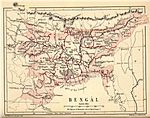| History of Bengal |
|---|
 |
| History of South Asia |
|---|
 |
The Greater Sylhet region predominantly included the Sylhet Division in Bangladesh, and Karimganj district in Assam, India. The history of the Sylhet region begins with the existence of expanded commercial centres in the area that is now Sylhet City. Historically known as Srihatta and Shilhatta, it was ruled by the Buddhist and Hindu kingdoms of Harikela and Kamarupa before passing to the control of the Chandra, Sena and Deva dynasties in the early medieval period.[1][2] After the fall of these Buddhist and Hindu principalities, the region became home to many more independent petty kingdoms such as Jaintia, Gour, Laur, and later Taraf, Pratapgarh, Jagannathpur, Chandrapur and Ita. After the Conquest of Sylhet in the 14th century, the region was absorbed into Shamsuddin Firoz Shah's independent principality based in Lakhnauti, Bangladesh. It was then successively ruled by the Muslim sultanates of Delhi and the Bengal Sultanate before collapsing into Muslim petty kingdoms, mostly ruled by Afghan chieftains, after the fall of the Karrani dynasty in 1576. Described as Bengal's Wild East, the Mughals struggled in defeating the chieftains of Sylhet.[3] After the defeat of Khwaja Usman, their most formidable opponent, the area finally came under Mughal rule in 1612.[4] Sylhet emerged as the Mughals' most significant imperial outpost in the east and its importance remained as such throughout the seventeenth century.[5] After the Mughals, the British Empire ruled the region for over 180 years until the independence of Pakistan and India. There was a complete list of the different amils who governed Sylhet which was recorded in the office of the Qanungoh (revenue officers) of Sylhet. However, most complete copies have been lost or destroyed. Dates from letters and seal traces show evidence that the amils were constantly changed.[6] In 1947, when a referendum was held, Sylhet decided to join the Pakistani province of East Bengal. However, when the Radcliffe Line was drawn up, Karimganj district of Barak Valley was given to India by the commission after being pleaded by Abdul Matlib Mazumdar's delegation. Throughout the history of Sylhet, raids and invasions were also common from neighbouring kingdoms as well as tribes such as the Khasis and Kukis.
- ^ Cite error: The named reference
Chakrabarti1992was invoked but never defined (see the help page). - ^ Syed Umar Hayat (July–December 1996). "Bengal Under the Palas and Senas (750-1204)" (PDF). Pakistan Journal of History and Culture. 17 (2): 33.
- ^ Cite error: The named reference
wildeastwas invoked but never defined (see the help page). - ^ Atul Chandra Roy (1968). History of Bengal: Mughal Period, 1526-1765 A.D. Nababharat Publishers. p. 100.
- ^ Nath, Pratyay (28 June 2019). Climate of Conquest: War, Environment, and Empire in Mughal North India. Oxford University Press.
- ^ E M Lewis (1868). "Sylhet District". Principal Heads of the History and Statistics of the Dacca Division. Calcutta: Calcutta Central Press Company. pp. 281-326.